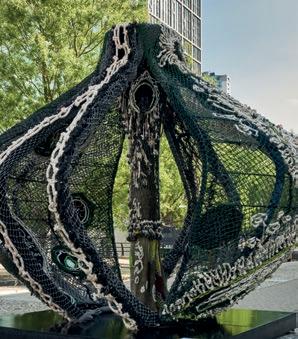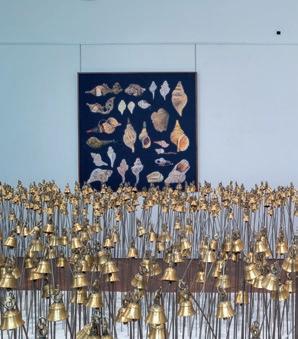
3 minute read
Your guide to
Liverpool’s known for its creative scene, and throughout summer the city is hosting the largest festival of contemporary visual art in the UK – Liverpool Biennial.
This year’s festival is titled ‘uMoya: The Sacred Return of Lost Things’, taking its name from the isiZulu word (pronounced oo-moy-ah) which means spirit, breath, air, climate and wind.
Advertisement
Curated by Khanyisile Mbongwa with Biennial Director Dr Samantha Lackey and the Liverpool Biennial team, the theme reflects on the history of Liverpool, in particular its colonial past, and its role in the trade of enslaved people and the making of the British Empire, and looks ahead to a very different future.
This year is the 12th edition of the festival, which takes over a wide variety of different venues – expected and unexpected – every two years.
Since it was first formed in 1998, it has commissioned 380 artworks, presented work by more than 560 leading artists, delivered 34 collaborative neighbourhood projects and hosted 49 million visits!
From the beginning, Liverpool Biennial has commissioned new artwork, some of which can still be seen today in the city, including Sir Peter Blake’s Razzle Dazzle Ferry and Ugo Rondinone’s Liverpool Mountain outside Tate Liverpool at Royal Albert Dock.
This year, for the first time, the venues include Tobacco Warehouse meaning Titanic Hotel is one of the best locations for viewing.
A festival hub is also based at Tobacco Warehouse on the ground floor’s waterside space and hosts six artists who give their own interpretation of ideas around repair and healing.
Other venues include the old restaurant in the Cotton Exchange, Liverpool ONE, St John’s Gardens behind St George’s Hall, Liverpool Parish Church St Nicholas and arts venues such as Tate Liverpool, Bluecoat, FACT Liverpool, Victoria Gallery and & Museum, Open Eye Gallery and World Museum.
Featuring 35 artists and collectives from the UK and around the world all responding to the theme, a diverse programme of free exhibitions, performances, screenings, community and learning activities and fringe events takes place over 14 weeks, closing on September 17.
Artists come from Alaska, Australia, Austria, Botswana, Brazil, Columbia, France, El Salvador, Germany, Guatemala, Iran, Italy, Martinique, Mozambique, Nigeria, Palestine, Peru, Rwanda, South Africa, Taiwan, Trinidad and Tobago, Uganda, UK, USA, Zambia, and Zanzibar.
Liverpool Biennial outdoor works are in situ across the city centre, so they’re impossible to miss, but here are Navigator’s highlights to look out for…
NICHOLAS GALANIN AT ST JOHN’S GARDENS
A newly commissioned piece by Nicholas Galanin has been installed at St John’s Gardens, next to St George’s Hall. A display of bronze casts of handwoven baskets references museum displays of indigenous North American and African basketry and cinematic portrayals of thieves via ski-mask cut-outs. A video work by the artist is also being shown at Bluecoat on School Lane.
Brook Andrew At Stanley Dock

Brook Andrew presents a bold, new large-scale neon work at Stanley Dock. Combining languages including Irish Gaelic, isiZulu, Wiradjuri, Urdu, Mandarin and Welsh, the commission symbolises the cultural and historical language diversity of Merseyside across the Liverpool skyline. A video work by the artist is also being shown at World Museum.
Ranti Bam In St Nicholas Gardens
Ranti Bam has created a major new sculptural commission especially for the gardens of St Nicholas Liverpool Parish Church, where the first recorded Black resident in Liverpool, Abell, an enslaved African, is buried. Visitors will be invited to interact with the works, which have been modelled to the size and shape of the artist's embrace.

Festival Hub At Tobacco Warehouse
The Grade II listed Tobacco Warehouse is the largest brick warehouse in the world, covering 1,600,000sqft, and as the festival hub it has become a temporary home to six artists: Albert Ibokwe Khoza’s ‘The Black Circus of the Republic of Bantu’, Melanie Manchot’s long-form film project ‘STEPHEN’, and work by Binta Diaw, Isa do Rosário, Julien Creuzet and Rahmi Hamzi.

Eleng Luluan At Princes Dock
A monumental sculpture by Eleng Luluan, taking the form of a giant metal vessel, has been unveiled at Princes Dock, Liverpool Waters. The work is inspired by the legend that the founder of Rukai was born from a pottery jar protected by two snakes and draws on the artist’s own experience of growing up in the Kucapungane community in Taiwan.
Rudy Loewe At Liverpool One
At Liverpool ONE, Rudy Loewe presents a new largescale installation inspired by the Liverpool Sailors’ Home gates and based on the artist’s painting ‘February 1970, Trinidad #1’. It depicts Moko jumbie, a stilts walker or dancer, and other Carnival participants coming to the aid of the people at a moment of Black Power revolution in Trinidad and Tobago.
ANTONIO OBA AT VICTORIA GALLERY & MUSEUM (UNIVERSITY OF LIVERPOOL)
At Victoria Gallery & Museum, alongside new works by Charmaine Watkiss and Gala Porras-Kim, Antonio Oba’s interactive installation Jardim consists of hundreds of brass bells. It invites visitors to follow a path through the work and encourages them to get hands-on through the ringing of the bells.








